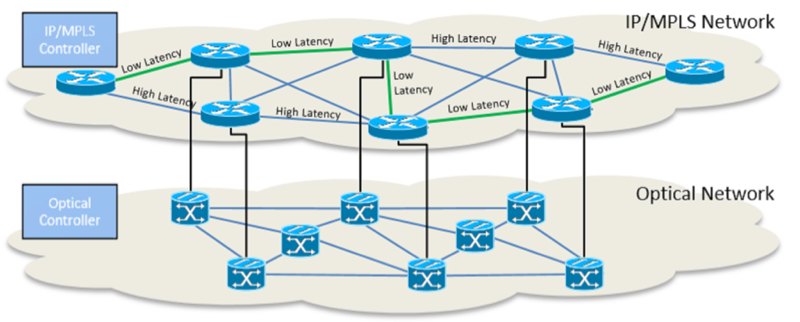Monitoring and managing multi-layer, multi-service networks
With the advent of multi-layer, multi-service provider networks, monitoring and management are more complex than ever before. While network operators can gain insights into the health of the IP network—including routing, traffic, and performance using a mix of packet, SNMP, and flow-based monitoring tools—consolidating and correlating this point-specific data into actionable knowledge is challenging.
Add multi-layer and multi-service to this mix, and network engineers are limited by the lack of a comprehensive and meaningful view of network performance. For example, without visibility into the underlying optical layer combined with multi-layer analytics, operators cannot perform optimal traffic engineering that exploits the performance, protection, and cost characteristics of each layer.
The monitoring challenges in multi-layer, multi-service networks
Many service provider networks are multi-layered. These consist of the IP/MPLS layer, which supports constraint-based destination routing, and the optical layer. With its high speeds and superior bandwidth utilization capabilities, the optical layer allows the transport of large traffic volumes over long-distance point-to-point fiber links.

A multi-layer network.
However, when it comes to monitoring multi-layer networks, there are no unified network monitoring tools that can collect and correlate network performance data from Layer 0 to 3. This lack of end-to-end, correlated visibility means that network engineers managing the optical network are not aware of any possible performance issues at the IP layer, and vice-versa. This, in turn, affects network planning, traffic optimization, and troubleshooting of service delivery issues.
For instance, the failure of an optical fiber that carries multiple IP/MPLS links can result in traffic being dynamically rerouted over another IP link. But this new link can end up being over-utilized due to the sudden shift in traffic, thereby impacting overall network performance and data delivery.
Multi-service networks present another set of challenges. In the past, service providers had networks dedicated to different customers and their applications. That has changed; now service providers use the same underlying network to deliver different applications, ranging from banking and trading data to live voice and video streaming. Running multiple applications over a converged network is complex, since each has unique performance requirements, growth rates, and fault-tolerance characteristics.
For example, congestion on one link can result in dynamic rerouting of traffic over a longer, high-latency link that is not suitable to low-latency applications such as banking or trading. With only static performance metrics collected using SNMP or flow analytics, network engineers are left blind to these changes that can result in failure to meet SLAs, and customer dissatisfaction.
Network analytics solution
To run effective multi-layer, multi-service networks, service providers and network operators require visibility into routing, traffic, and network performance, along with insights into the performance of the underlying optical layer. But in large, complex networks, this data is useful only if the network engineer can determine how a performance issue is affecting routing or data delivery in another part of the network.
This can be achieved by using a network analytics tool that collects and processes routing, traffic, and performance metrics and consolidates them to provide actionable intelligence. For instance, correlation of routing and performance measurements can help a network engineer understand how device errors notified by SNMP are causing traffic to be rerouted over a longer, high-latency path, resulting in connectivity issues.
Another capability needed is visibility into both the optical and IP/MPLS layers, which not only aids faster troubleshooting of network issues, but also helps network operators achieve benefits such as assuring truly diverse paths or data sovereignty.
The correlation of network analytics data from different layers helps network engineers understand present and past network behavior, detect potential issues, and predict outages even before end-users have a chance to complain.
Blue Planet Route Optimization and Assurance (ROA) can provide the analytics and intelligence required to manage multi-layer, multi-service networks. By combining ROA with Blue Planet Multi-Domain Service Orchestration (MDSO), service providers can both monitor and enable intelligent automation in their multi-layer networks for faster provisioning and fault avoidance.
Contact us to learn more about Blue Planet products: https://www.blueplanet.com/contact.
This content was originally published on the Packet Design blog and has been updated since the acquisition by Blue Planet.

